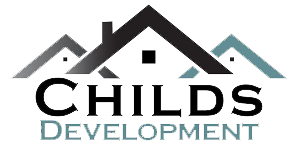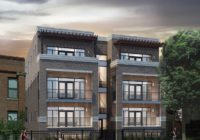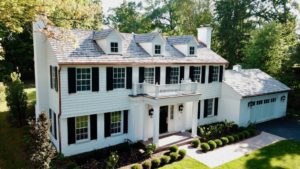Lake Forest, best known for its grand old mansions nestled on big wooded lots, also has a walkable center-of-town neighborhood that a 29-year-old developer believes has almost everything the millennial generation wants.
“You can walk to the train, you can walk to the lake, to restaurants and stores,” Peter Childs said, “but it’s not as nightlife-friendly as some places.”
The latter may not be high on the priority list for millennial parents, and that’s the crowd Childs is courting.
Since 2015, Childs has sold seven rehabbed and expanded houses within about a mile of Lake Forest’s main Metra station, all for $850,000 or less. Four sold to millennials, he said, and three to another population with similar housing needs: downsizers.
This week, Childs is launching his eighth: He’ll turn a plain 1.5-story bungalow on Griffith Road into a farmhouse-style two-story with architectural details on the exterior and an entirely new interior. (See before-and-after images below.)
The asking price, not yet determined, will be in the same range, he said. Childs, who lives in the city and doesn’t have kids, runs a branch of Childs Development, a custom homebuilding company in Lake Forest owned by his father, Jamie, and is the listing agent for the homes he rehabs.
“Millennial buyers want it to be new,” he said. “They’re not going to buy that old house and rehab it themselves.” Millennials, born between 1980 and 1995, are now 22 to 37 years old.
In April, Alex Bernardin and her husband, Nicolas Stahl, both in their early 30s, bought a four-bedroom house Childs rehabbed on Summit Avenue, moving from West Town in the city with their first child. (They now have a second.) Stahl walks five blocks to the Metra station to commute to his job in private equity in the Loop, and the family can walk to a handful of restaurants. “We know it’s not downtown Chicago,” said Bernardin, an at-home mom, “but we like living close to a central area and the train. We feel like we still have access to a lot of things without getting in the car.” Lake Forest is 33 miles north of Chicago.
Lake Forest’s public schools are also a draw. The three elementary and two middle schools, though not within walking distance of downtown, all rate nine or 10 (out of 10) by Great Schools, a national rating program based in Oakland, Calif.
Childs said that in more high-flying days in the real estate market, the houses he rehabs would most likely have been torn down and replaced with homes that listed at $1.3 million or more. But in the slow market that has prevailed in Lake Forest for a few years now, “that price is too much risk for these buyers,” he said. Rehabbing existing homes shaves a few hundred thousand dollars off the finished asking price.
For most of the seven completed projects, Childs said, he negotiated a deal with the past owners that gave him time before buying to line up buyers for it in its future rehabbed state. They’re willing to wait, he said, because “they know their houses are going to be torn down or rehabbed,” he said, and when he already has his buyers lined up, the reduced risk of carrying it means he’ll pay slightly more to obtain it.
On one recent project, he said, the seller might have gotten $310,000 from a builder who didn’t have a buyer in hand, but Childs paid $340,000 on the delayed deal. “It’s a bargaining chip,” he said. “I’m willing to pay that premium if they’re willing to wait.”
He’s now completing an already-sold house on Griffith Road, near the plain bungalow that comes next. It has four bedrooms and three full baths—all new construction inside a rehabbed and expanded shell. The house was about 750 square feet when he bought it; it’s now 2,100 square feet. The buyers paid about $715,000, Childs said.




